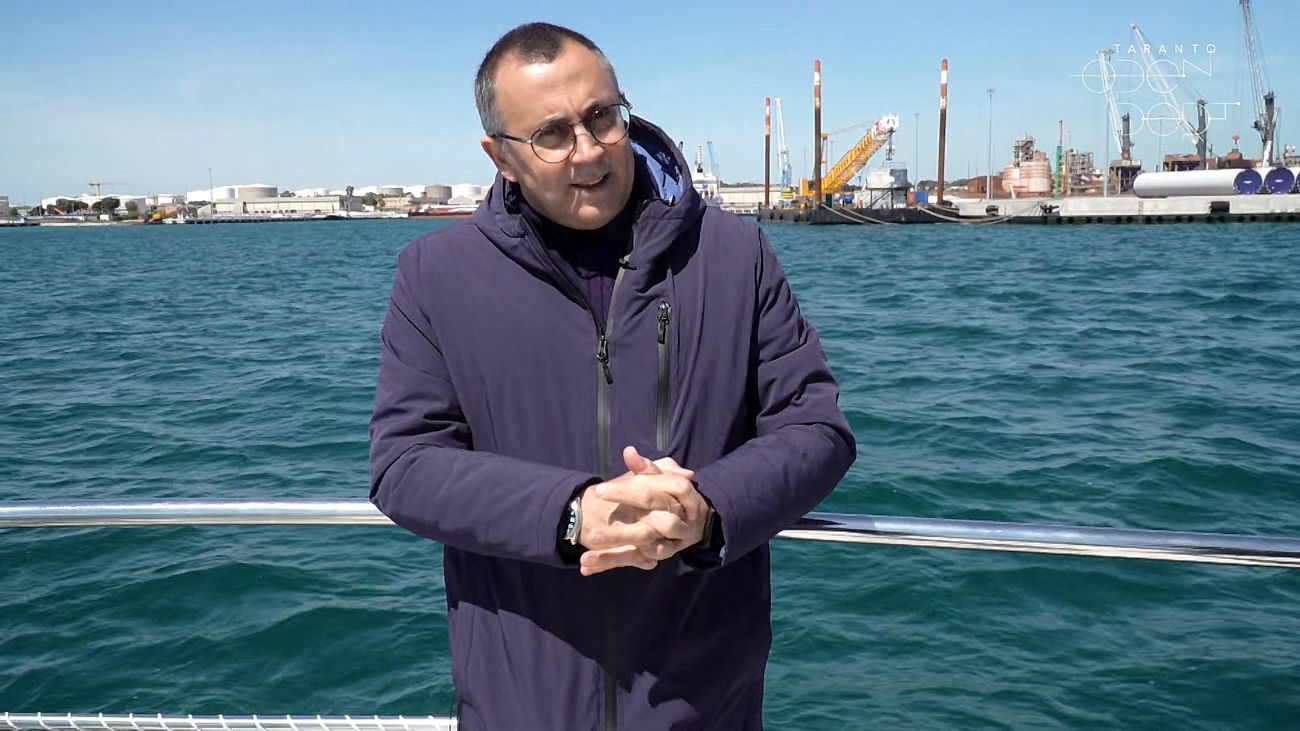Gianfranco Gisonda Interview
The port seen from the sea
The port seen from the sea
We are at the first jetty of the port of Taranto, this is the historic area of the port with the dock which has been renamed Darsena Taranto (Taranto Dock) precisely because it is the oldest part.
Here, for example, oil and flour were traded on St Eligius quay, which is the quay on your right, while on your left there is the Saint Catald quay, with the statue of the saint at its extremity.
Here you can see a commercial ship, which is docked at the west end of the San Cataldo quay and right now they are loading wind turbines which are manufactured by Vestas, which lies in the immediate hinterland.
And they come here to be loaded to be sent all over the world.
They are mainly used in the wind farms that are being built in the Northern Seas
The second jetty
In contrast, what we see here is the second jetty, and it is completely dedicated to the steel industry.
Behind it you can see all the cranes unloading the ore and via those conveyor belts it is then transported directly to the plant.
The boat you can see is one that mitigates the environmental impact.
There are also booms called “panne” all around the ship, which are used specifically to ensure that any mineral deposits do not end up in the sea, and with that boat any excess dust is then recovered and discharged into the sea.
What we see here is a typical loading operation for steel coils, which are then loaded by means of cranes, also located on the quay.
These coils are generally going to be used to make motor vehicles.
The fourth jetty
The port of Taranto was constructed in this area around the 1960s with the advent of the steel industry.
In fact, in this way it was built (the fourth jetty) at a depth of 25 metres and is therefore equipped to receive ore ships like the one we see, which are among the largest in the world.
The ore ships that arrive here mainly come from South America and, having such deep waters, the port of Taranto is capable of accommodating the biggest ships.
This seabed is the deepest in Europe.
The harbour protected by the Cheradi islands
The port of Taranto is south-facing, so it has four quays in the harbour section, which is the area most protected from the action of the waves, and then a further quay, also serving the large steel industry, in the area outside the harbour.
The part in the harbour is sheltered by the Cheradi islands, so the port is built in such a way as to have projections, thus the quay…the east side and west side quays.
They are defined as such because, for example, when a ship has to dock, it notifies the harbourmaster of the exact position where it has to moor, but many don’t know that the Cheradi islands were not just the two, St Peter and St Paul.
Originally there was also the island of San Nicolicchio, which was then incorporated into the land area and we are now in the dock which came to be called the ‘San Nicolicchio’.
In this area, planking from a boat was found, which we recovered thanks to the help of the Superintendency.
The oil wharf
Taranto not only has a steel industry but also an industry for processing petroleum products.
What we see now is the Eni jetty.
The crude oil arrives by means of ships that transport the oil and can be unloaded in this area, or smaller vessels can be loaded with the finished product, the processed product.
Pinna nobilis in the harbour bed
In recent years, the port of Taranto has undergone important infrastructure works, for example, the construction of a logistic platform, which is a place where goods can be processed.
During the renovation work, about a thousand giant fan mussels were found, and thanks to a collaboration with the CNR we were able to transfer them so that they continue to live in the area in front of Punta Rondinella, which you can see behind me and which is also an area of archaeological significance.
The fan mussel is important to Taranto because it was here that the famous byssus was extracted from which textiles were made.
This shows that the port, despite the presence of industry, continues to demonstrate a purpose that is also environmental, which is important because species continue to live here such as dolphins, tuna and turtles, which we have saved and protected thanks to the work of the CNR and the institute here in Policoro for the protection of turtles.
The port outside the harbour
This reef marks the boundary of the port area inside the harbour, separating it from the port outside the harbour.
In fact, behind us you can glimpse the cranes of the multi-sectoral quay, which is a structure built in the 1980s, covering about a million square metres, and which was restructured during the 2000s and then once again underwent major restructuring to increase its depths and is now capable of accommodating ships carrying containers, i.e. container ship.
And for this reason, the port of Taranto now has a fully commercial focus as well as being an industrial port.
*** Automatically generated subtitles ***


